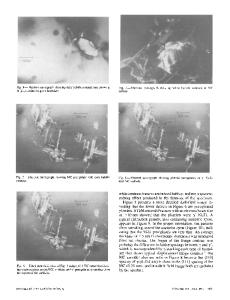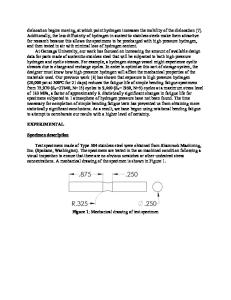Fatigue of stainless steel in hydrogen
- PDF / 1,175,670 Bytes
- 6 Pages / 612 x 792 pts (letter) Page_size
- 62 Downloads / 384 Views
I.
INTRODUCTION
AUSTENIT1C stainless steels are susceptible to hydrogen embrittlement both due to a hydrogen atmosphere and due to dissolved hydrogen. There is a growing body of evidence that the effect of hydrogen is more drastic the more unstable the austenite. It seems likely that the rate of crack growth is controlled by the rate at which hydrogen arrives in the region ahead of the advancing crack. This rate is influenced by surface processes, the presence and nature of hydrogen trapping sites, phase composition, and possibly by dislocation sweeping and pipe diffusion. In a fatigue situation these factors all become functions of time and stress and strain history, thereby enormously complicating the analysis of the problem. In the present work we have investigated the magnitude of enhancement of fatigue crack growth rate (FCGR) by the presence of hydrogen gas and studied the effect of austenite stability on the process. The experiments complement those recently reported on the effect of austenite stability on FCGR in inert environments ~,~and other experiments on the effect of austenite stability on slow crack growth (SCG) under constant load in hydrogen-containing stainless steel alloys. 3'4'5 In each case the stress-induced transformation of Y to a ' martensite was shown to be an important factor, and the conditions under which transformation occurs and some of the reasons for its importance were explored. In the present study the FCGR in hydrogen gas of a relatively unstable alloy, AISI 301, was compared with that of a relatively stable alloy, AISI 302.
II.
EXPERIMENTAL PROCEDURE
Commercial alloys of AISI 301 and 302 in the form of 25 mm wide by 1.5 mm thick strips were fatigue tested in tension under load control with R = +0.05. These are the same alloys for which FCGR kinetics were determined in inert environments. 1,2The two alloys contained C r / N i / C / N contents (wt pct) of 17.1/7.25/0.052/0.038 for 301 and
G. SCHUSTER, formerly with the Department of Metallurgy, University of Illinois at Urbana-Champaign, is now with Owens/Coruing Fiberglas Technical Center, Granville, OH 43023. C. ALTSTETTER is with the Department of Metallurgy, University of Illinois at UrbanaChampaign, Urbana, IL 61801. Manuscript submitted October 5, 1982.
METALLURGICALTRANSACTIONS A
17.4/10.2/0.084/0.046 for 302 and had yield stresses of 269 MPa and 241 MPa and calculated* MD30 temperatures *Picketing has found the following correlation between Mo3o and alloy composition in wt pct: MD30 = 497-462 (C + N)-13.7 (Cr)-20 (Ni)-18.5 (Mo)-8:1 (Mn)-9.2 (Si), where MD3o(°C) is the temperature at which 50 pct martensite is formed after a true strain of 0.30. 6,7
of 57 °C and - 2 2 °C, respectively. The experimental techniques and alloys are discussed elsewhere, j'2 but, briefly, the specimens were notched by making a 5 to 10 mm long slow speed diamond saw cut at the midpoint of one edge. After electropolishing, a fatigue crack was introduced using a frequency of 3 Hz. Then the frequency was usually reduced to 0.6 Hz and the adv
Data Loading...











